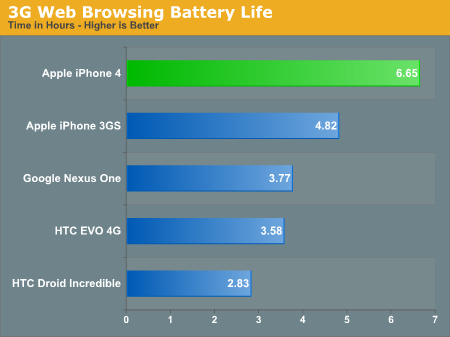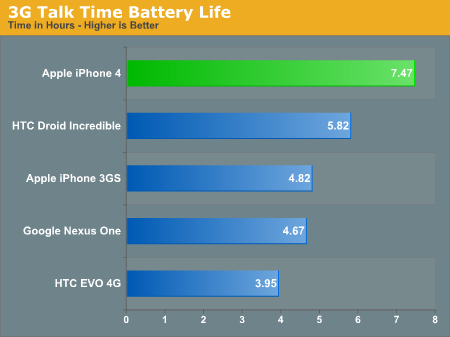Apple's iPhone 4: Thoroughly Reviewed
by Brian Klug & Anand Lal Shimpi on June 30, 2010 4:06 AM EST- Posted in
- Smartphones
- Apple
- iPhone 4
- Gadgets
- Mobile
Incredible Battery Life
I’ve publicly praised Apple for its honesty in reporting battery life over the past couple of years, and the iPhone 4 gives me no reason to stop.
The 4 has an integrated 5.25Whr battery. That’s around 95% of the battery capacity of the HTC EVO 4G, despite having much lower power frequirements. It’s also a 16% increase over the 4.51Whr battery that was in the iPhone 3GS. This means at bare minimum, assuming the iPhone 4 doesn’t draw any more power than the 3GS, we should get 16% more battery life.
In reality, we get much more.
When Apple introduced the iPhone 3G it dropped battery life to a level that we’d been stuck at ever since. The 3GS improved battery life a bit through better CPU power efficiency but you still didn’t have enough juice to get through a day without charging.
The iPhone 4 changes all of that. The combination of a larger battery and a more power efficient SoC results in an incredible amount of battery life.
Our first test is a basic web browsing benchmark. We've scripted almost two dozen webpages to load, pause for 20 seconds, then forward on to the next page. None of the pages use any Flash. This process repeats until the battery is dead. Screen brightness on the iPhones was set to 50% and the screens remained on the whole time.

Battery life improved nearly 38% with the iPhone 4. It's clear that while the A4 improved performance, the real improvement was in battery life. This test has enough idle time where good power management and low idle power can really impact the results. There's simply no other similar smartphone that can touch the 4's battery life.
We then repeated the same test over WiFi instead of 3G:

Apple claims the iPhone 4 will last for up to 10 hours over WiFi, we measured just under that at 9.96 hours. The improvement here is only 12.8%, which tells me that we're nearing the limit of how efficiently Apple can manage power in WiFi mode. There's a wall that we're quickly approaching with this current architecture.
To measure talk time we play MP3s on repeat into the mic of a phone and use it to call the phone being tested. The process continues until the test phone dies. In this case the screen is allowed to go to sleep, as it normally would be if you were talking on the phone:

Apple promised up to 7 hours of 3G talk time with the iPhone 4. We measured 7.47 hours. That's an increase of 54.9% over the iPhone 3GS. While in a phone call the majority of the A4 SoC is powered down, so the efficiency improvements here have to do with how much less power the A4 consumes while off and the new Skyworks 3G modem (the iPhone 3GS used an Infineon modem).
In our iOS 4 review we looked at the impact multitasking had on the iPhone 3GS' web browsing battery life. I ran our 3G web browsing test while playing music through Pandora in the background. I repeated the test with the iPhone 4 for today's article:

We actually see our largest battery life improvement in this test. With a 57.7% increase in battery life over the 3GS, the iPhone 4 is not only more efficient at idle workloads but also when the SoC is constantly busy. The A4 SoC is rumored to be built on a 45nm process compared to the 65nm SoC used in the 3GS. With a moderate increase in clock speed we should be seeing a lot of the power savings that a full node shrink brings to the table.
The battery life offered by the iPhone 4 is spectacular. My iPhone 3GS could hardly get through a full day of work while traveling, I'd always need to hunt for an outlet before heading into my dinner meeting. I'm about to take my first trip with the iPhone 4 but I get the feeling that I might finally be able to make it through dinner.
Early reports of 20 and 30 hours of battery life are simply exaggerated. They're only possible if you let the phone idle in your pocket for the majority of that time. In other words, if you don't use the phone it lasts for a long time. While that's a testament to the platform's incredible idle power, the real world usage is good enough to stand on its own. It's better than any iPhone or Android phone I've tested thus far.










270 Comments
View All Comments
JAS - Wednesday, June 30, 2010 - link
The build quality of the iPhone 4 is outstanding. It reminds me of Nagra (Swiss-made) professional tape recorders I have used. Very solid.The edges of the iPhone 4 are not as smooth as those on the iPhone 3GS; but they aren't "sharp" or prone to cutting your pants when you slide the device into your pocket.
Still, I would want to use a rubber/silicone "skin" on the iPhone 4, not just a bumper, primarily to improve its grasp.
jsbruner - Wednesday, June 30, 2010 - link
I see the reception bar issue as well but do not experience any dropped calls because of it. However the biggest issue I have is with the proximity sensor. I have accidentally hung up numerous times because the screen lock turns off and the buttons become active. I watched myself in a mirror talking and I see the phone flickering on and off. Have you seen this issue at all? Would the bumper minimize this issue?Great article.
Wolfpup - Wednesday, June 30, 2010 - link
While in theory I'd love higher resolution displays on monitors, in practice they're already too high, and can't get any higher until somehow operating systems are able to offer true resolution independence where ANY program (even if it's written in 1988) will be flawless scaled so it's the right size at a given resolution. So far the ONLY example in the computer world of this being done right is on Palm devices, where they just quadrupled the resolution and on older programs 1 pixel = 4 real pixels. Presumably it's the same on iOS.But until OSes can do that that successfully on ANY content on ANY monitor at ANY resolution, raising the resolution is a TERRIBLE idea, as we're already WAY past the point of usability on a lot of displays, since stuff just keeps shrinking rather than adding detail.
inperfectdarkness - Wednesday, June 30, 2010 - link
"If there's one thing I hope the iPhone 4 display does, it's generate demand for 300 PPI level desktop displays - the era of 110 PPI displays being the norm needs to end now."i could not have said it better. 1080p on a 17" screen is pathetic for a laptop.
minememy21 - Wednesday, June 30, 2010 - link
I registered just for the sole purpose of saying thank you to Brian and Anand.I really appreciate the amount of work and objectivity you've put in this review. I don't know of any other site with the same level of dedication and thoroughness.
Please don't pay attention to the few, vocal, and overly sensitive anti-apple crowd and just continue writing the way you do.
HilbertSpace - Wednesday, June 30, 2010 - link
"Perhaps even use diamond vapor deposition (like they did with the glass screen atop the iPhone 3GS) to insulate the stainless steel from users." -The Real Story on iPhone 4's Antenna.There's no way apple used physical vapor deposition (PVD) on the iPhone 3GS, way too expensive! Supposedly a Nokia Vertu phone adds a TiC coating - the cost - oh only ~$15000!
gronkman - Wednesday, June 30, 2010 - link
The word on the grapevine is that the antenna issue will be dealt with by an upcoming software update. What I am interested in is whether it will really change the antenna attenuation, or whether it will "fix" the bars just by not showing the bar degradation. I'm hoping AT will do an in-depth look at the update when/if it comes out.thomas.magnum - Wednesday, June 30, 2010 - link
I am not sure what you mean when using 40% in the context of the bar. But I think you need to improve the discussion of dB. Because it runs on a log scale, changes in dB are more complex than just looking at dB1-dB2 and computing percentage. You really need to think about 10^(dB/10). I would bet that the bars are setup to be representative of a dB scale. NOT simple percentages base on dB numbers, like you're trying to do.The0ne - Wednesday, June 30, 2010 - link
Your comment reminds me of richter scale :) Most people will look at 6.0 and 7.0 and say oh that's nothing hahaha If only they knew they'll be completely shocked. Sorry, I had a good laugh out of this.strikeback03 - Thursday, July 1, 2010 - link
Of course that is also assuming they think the Richter scale is still in use.